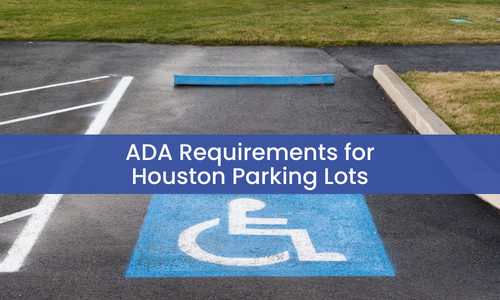The American Disabilities Act (ADA) requires Houston facilities to abide by certain regulations when installing a parking lot. These regulations cover the vast majority of businesses, so if your company is building or updating its parking lot, you’ll need to observe the ADA requirements.
Properties Required to Follow Houston ADA Accessibility Regulations
Companies that sell goods or services to the public, nonprofits, and government facilities must follow ADA regulations regarding parking lots. State and local government facilities are included in these requirements.
There are significant penalties for noncompliance. For a first-time violation, businesses may be fined up to $75,000. Subsequent violations may be fined up to $150,000 each. These are federal penalties, so state and local governments may levy additional fines.
ADA noncompliance also exposes your business to legal action. For example, civil lawsuits may be filed using ADA regulations as justification.
Texas Accessibility Standards for Parking Spaces
Houston is governed by the Texas Accessibility Standards (TAS). Authored in 2012 and still enforced, the TAS were written to work with the ADA’s federal standards. The TAS does include additional specifications for certain spaces, such as piers, golf courses, play facilities, spas, and swimming pools.
In general, Texas businesses must adhere to the following parking lot requirements:
ADA Requirements for Number of Accessible Parking Spaces
The total size of your parking lot will dictate how many accessible parking spaces must be in place. Here are the numbers:
- One to 25 parking spaces – One accessible space
- 26-50 parking spaces – Two accessible spaces
- 51-75 parking spaces – Three accessible spaces
- 76-100 parking spaces – Four accessible spaces
- 101-150 parking spaces – Five accessible spaces
- 151-200 parking spaces – Six accessible spaces
- 201-300 parking spaces – Seven accessible spaces
- 301-400 parking spaces – Eight accessible spaces
- 401-500 parking spaces – Nine accessible spaces
- 501-1,000 parking spaces – 2 percent of total number of parking spots
- Over 1,000 parking spaces – 20 plus one for each 100 spots over 1,000
One out of every eight accessible parking spots (12.5 percent) must be van accessible as well. At a minimum, there must be at least one available van-accessible space, no matter your lot’s size.
There are some exceptions to the above numbers. Medical facilities, rehabilitation centers and physical therapy clinics require additional accessible spaces.
Proximity of Each ADA Parking Space to the Building
Accessible parking spots must be located on the shortest accessible route to the nearest accessible entrance. If the parking lot is used by multiple businesses, accessible spaces must be placed on the shortest route to the nearest pedestrian entrance leading into the parking lot.
If there are multiple entrances leading into a single facility, accessible spaces must be divided among them and located as close as possible to each entrance.
The Size Requirement of Each ADA Accessible Parking Space
ADA-compliant parking spots must be at least 96 inches wide, with an adjacent 60-inch access aisle next to the space. Van-accessible spaces must be at least 96 inches wide, with an adjacent 96-inch-wide access aisle next to the spot. This additional width is meant to accommodate a side-loading ramp out of the vehicle.
Alternatively, Houston parking lots may use a “universal” parking space design instead. Universal spaces must be at least 132 inches wide, with a 60-inch access aisle adjacent to the space. With their expanded dimensions, universal spaces can accommodate all vehicles, including vans with loading ramps or lifts.
The Slope Requirement of Each ADA Accessible Parking Space
Accessible parking spaces and access aisles must be as level as possible, with only a 2 percent slope allowed in any direction. When selecting spots for accessible spaces, the most level area should be prioritized.
The Signage Required for Each ADA Accessible Parking Space
ADA-compliant parking spaces must be marked with a sign and parking lot striping. Each sign must be mounted at least 60 inches off the ground, or 80 inches if it’s placed on an accessible route and the sign projects at least 4 inches from the pole.
Signage must include the international symbol for accessibility and an additional sign denoting van accessibility, if applicable. Whether mounted to a walkway or to parking lot bollards, each sign must provide at least 36 inches of clearance from the accessible route to eliminate possible obstructions. Accessibility signs must be installed so that they are not obscured when a vehicle is in the parking spot.
The ADA Requirements for Parking Lot Striping
ADA accessible parking spaces and access aisles require proper pavement markings to help them stand out more. Parking spaces must be marked with the international symbol for accessibility, and access aisles must be marked by a diagonally hatched box. Both should be striped using paints designed for pavement. Colors should be selected for contrast up against the pavement as higher contrast means better visibility.
ADA Requirements for Passenger Loading Areas and Access Aisles
Accessible parking spots must be located adjacent to an access aisle, which must be at least 60 inches wide and 20 inches long. The access aisle may be located on either side of the vehicle, but it must be parallel to the pull-up space.
If an accessible space is placed next to a curb, the curb must feature a wheelchair ramp that adheres to ADA standards.
An Experienced Houston Pavement Contractor Will Ensure Your Parking Lot is ADA Compliant
ADA compliance is a mandatory part of parking lot installation, so it’s something your pavement contractor should prioritize. That includes federal, state and, in Houston, local requirements.
Given the potential penalties, experienced Houston paving contractors ensure their work observes all ADA regulations and that their parking lots are fully ADA compliant.
- HOA & Condos – How Asphalt Pavement Can Affect Your Houston Property Values - March 6, 2025
- What Certifications or Licenses Should a Houston Asphalt Contractor Have? - September 17, 2024
- Common Challenges in Concrete Construction - September 11, 2024

